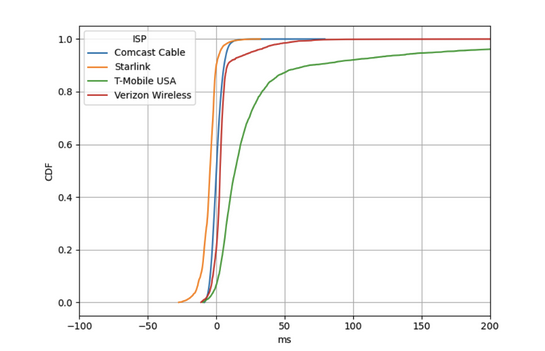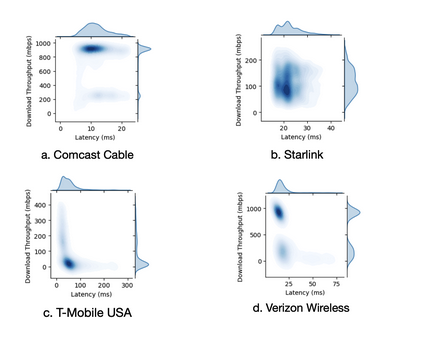
Network Latency: The Next Friontier of Digital Experience
Performance in Fixed Wireless Networks
Conventional single-connection TCP wired networks have long shown an inverse relationship between latency and throughput. New data from NetMicroscope’s global network measurement platform reveals that this relationship breaks down in fixed wireless environments. These networks show far higher performance variability than wired networks—challenging long-standing industry assumptions about how to evaluate broadband quality.
Using NetMicroscope’s continuous measurement infrastructure, deployed on embedded devices deployed in many major ISPs across the United States, we collect correlated throughput and latency metrics from multiple ISPs over many months; the measurements are ongoing.
The data suggests that the network performance landscape continues to evolve, that speed tests are increasingly obsolete, and that service providers need more comprehensive monitoring and diagnostic tools to understand how their network performance ultimately translates to user experience.
The conventional wisdom bears re-evaluation: We find no consistent correlation between throughput and latency—even within the same technology type. In fixed wireless scenarios, throughput often remains stable while latency fluctuates unpredictably. Increasingly, \throughput alone is not a reliable quality metric, especially for fixed wireless connections which show highly variable latency, particularly under load.
NetMicroscope Measures What Speed Tests Miss
NetMicroscope jointly and continuously measures latency and throughput in real-world home network conditions for both wired and fixed wireless ISPs.
Advantages of NetMicroscope:
- Continuous Measurement: Devices run measurement cycles every three hours, capturing idle latency, latency under load, and recovery periods.
- Real-World Deployments: From urban Chicago neighborhoods to rural satellite connections, our devices measure performance where users actually live and work.
- Cross-Technology Comparison: Our fleet compares cable, fixed wireless, and satellite ISPs on an equal footing—Comcast (cable), Verizon and T-Mobile (fixed wireless), and Starlink (satellite).
Fixed Wireless: Not Ready for Prime Time?
Throughput is not a reliable proxy for quality of service, particularly in fixed wireless environments. Across providers, we observe inconsistent or weak correlations between throughput and latency, with Starlink standing out for its highly variable performance and minimal relationship between the two metrics. This means that a speed test showing high throughput can mask significant latency issues that directly affect user experience.

Comcast Cable delivers consistent latency performance, with a moderate negative correlation between latency and throughput—higher throughput generally aligns with lower latency. Fixed wireless networks on the other hand—especially T-Mobile and Verizon—are prone to severe latency fluctuations, with both download and upload latency sometimes spiking far above baseline levels. These latency gaps between simple pings and actual data transfer suggest that network congestion, scheduling delays, or other factors can dramatically slow responsiveness even when bandwidth remains available. While Starlink tends to be somewhat more stable, it still exhibits moderate variability that can impact performance.
The ultimate implication for end users is that fixed wireless connections often deliver an inconsistent user experience. High throughput alone does not guarantee smooth video calls, responsive gaming, or rapid page loads—any of which can be degraded by latency spikes. For policymakers and regulators, the takeaway is equally clear: evaluating broadband quality based solely on throughput risks overlooking the true performance challenges of fixed wireless. A more accurate assessment must incorporate latency as a key metric, especially in technology contexts where it can fluctuate widely independent of available bandwidth.
Starlink, in contrast, shows minimal correlation; it exhibits highly variable throughput and latency, which ultimately translates to an inconsistent user epxerience, particularly gien the emergence of an increasing number of latency-sensitive application such as gaming and video conferencing.
T-Mobile USA exhibits a weak-to-moderate correlation, but is frequently affected by extreme latency spikes exceeding 300 milliseconds. Among the fixed wireless providers, Verizon Wireless demonstrates the strongest correlation between latency and throughput, yet still experiences notable high-latency anomalies.

Cable networks maintain stable performance, while on the other hand fixed wireless and satellite connections experience significant performance degradation under load—especially on upload.
The NetMicroscope Difference
NetMicroscope is a production-ready network performance observatory that:
- Captures real-world, real-time performance data.
- Identifies when high throughput masks poor user experience.
- Provides actionable insights to improve service delivery.
By integrating NetMicroscope into ongoing monitoring, network and service providers can detect and address network instability before degradations impacts customers, and validate that upgrades deliver measurable user experience gains—not just better speed test results.
Throughput-only benchmarks overlook critical aspects of user experience, particularly in fixed wireless environments. In contrast, NetMicroscope’s continuous, latency-focused analysis provides the visibility needed to ensure investments actually improve end-user quality of service.